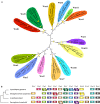Wnt Signaling Pathway Linked to Intestinal Regeneration via Evolutionary Patterns and Gene Expression in the Sea Cucumber Apostichopus japonicus
- PMID: 30838034
- PMCID: PMC6390002
- DOI: 10.3389/fgene.2019.00112
Wnt Signaling Pathway Linked to Intestinal Regeneration via Evolutionary Patterns and Gene Expression in the Sea Cucumber Apostichopus japonicus
Abstract
Many echinoderms are regenerative species that exhibit exceptional regenerative capacity, and sea cucumber is a representative organism that could regenerate the whole intestine after evisceration. There are many signaling pathways participate in the regeneration process, but it is not clear which is essential for the intestinal regeneration. In this study, we performed genome-wide comprehensive analyses on these regeneration-related signaling pathways, and found the Wnt signaling pathway was one of the most conservative pathways among regenerative species. Additionally, among these signaling pathways, we found that the Wnt signaling pathway was the only one under positive selection in regenerative echinoderms, and the only one enriched by differentially expressed genes during the intestinal regeneration. Thus, it suggests both coding sequence and gene expression of the Wnt signaling pathway have been shaped by natural selection to provide the genetic architecture for intestinal regeneration. Wnt7, Fz7, and Dvl are the three positively selected genes and also happen to be three upstream genes in the Wnt signaling pathway. They are all significantly upregulated at the early stages of regeneration, which may contribute significantly to the early activation of Wnt signaling and the initiation of intestinal regeneration. Expression knockdown of Wnt7 and Dvl by RNA interference significantly inhibit intestinal extension, implying that they are essential for intestinal regeneration. As an important regeneration-related gene, the downstream gene c-Myc is also conserved and highly expressed during the whole regeneration stages, which may make the Wnt/c-Myc signaling to be an important way to promote intestinal regeneration. Therefore, it is reasonable to conclude that the Wnt signaling pathway is the chosen one to play an important role in intestinal regeneration of sea cucumbers, or even in the regeneration of other echinoderms.
Keywords: Wnt signaling pathway; intestinal regeneration; natural selection; positive selection; sea cucumber.
Figures







Similar articles
-
Identification and expression characterization of WntA during intestinal regeneration in the sea cucumber Apostichopus japonicus.Comp Biochem Physiol B Biochem Mol Biol. 2017 Aug;210:55-63. doi: 10.1016/j.cbpb.2017.06.005. Epub 2017 Jun 22. Comp Biochem Physiol B Biochem Mol Biol. 2017. PMID: 28647408
-
Gene expression profiling of intestinal regeneration in the sea cucumber.BMC Genomics. 2009 Jun 8;10:262. doi: 10.1186/1471-2164-10-262. BMC Genomics. 2009. PMID: 19505337 Free PMC article.
-
RNA-Seq reveals dynamic changes of gene expression in key stages of intestine regeneration in the sea cucumber Apostichopus japonicus. [corrected].PLoS One. 2013 Aug 6;8(8):e69441. doi: 10.1371/journal.pone.0069441. Print 2013. PLoS One. 2013. PMID: 23936330 Free PMC article.
-
A Review of Histocytological Events and Molecular Mechanisms Involved in Intestine Regeneration in Holothurians.Biology (Basel). 2022 Jul 22;11(8):1095. doi: 10.3390/biology11081095. Biology (Basel). 2022. PMID: 35892951 Free PMC article. Review.
-
The interaction of Notch and Wnt signaling pathways in vertebrate regeneration.Cell Regen. 2021 Apr 1;10(1):11. doi: 10.1186/s13619-020-00072-2. Cell Regen. 2021. PMID: 33791915 Free PMC article. Review.
Cited by
-
Regeneration in Echinoderms: Molecular Advancements.Front Cell Dev Biol. 2021 Dec 17;9:768641. doi: 10.3389/fcell.2021.768641. eCollection 2021. Front Cell Dev Biol. 2021. PMID: 34977019 Free PMC article. Review.
-
Wnt/β-catenin signaling pathway regulates cell proliferation but not muscle dedifferentiation nor apoptosis during sea cucumber intestinal regeneration.Dev Biol. 2021 Dec;480:105-113. doi: 10.1016/j.ydbio.2021.08.011. Epub 2021 Sep 3. Dev Biol. 2021. PMID: 34481794 Free PMC article.
-
Transcriptome-Wide Characterization of piRNAs during the Developmental Process of European Honey-Bee Larval Guts.Genes (Basel). 2022 Oct 17;13(10):1879. doi: 10.3390/genes13101879. Genes (Basel). 2022. PMID: 36292764 Free PMC article.
-
Characterization and Expression Analysis of Regeneration-Associated Protein (Aj-Orpin) during Intestinal Regeneration in the Sea Cucumber Apostichopus japonicus.Mar Drugs. 2022 Sep 6;20(9):568. doi: 10.3390/md20090568. Mar Drugs. 2022. PMID: 36135757 Free PMC article.
-
A roadmap for intestinal regeneration.Int J Dev Biol. 2021;65(4-5-6):427-437. doi: 10.1387/ijdb.200227dq. Int J Dev Biol. 2021. PMID: 32930367 Free PMC article. Review.
References
LinkOut - more resources
Full Text Sources
Research Materials
Miscellaneous

